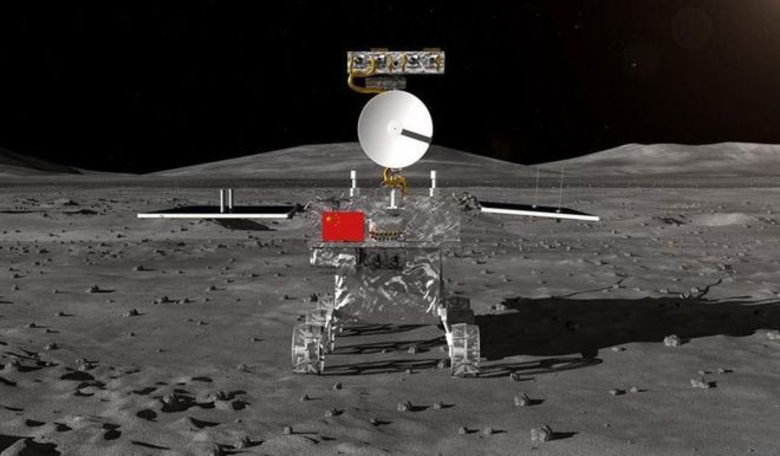Heading to a rugged, little-explored land populated with high mountains and one of the largest craters in the Solar System is China’s Chang’e 4 spacecraft. Its arrival will make history and once planted firmly on the ground, communication with Earth will be difficult. The craft however is not destined to spend years in space travelling to some distant far off planet, instead the robotic vehicle is expected to make a soft landing on the far side of our Moon in a few weeks time.
This first-ever surface mission to this unexplored region lifted off on 8 December at 18:23 GMT/2:23 a.m. local China time. Chang’e 4 is comprised of a static lander and a 140 kilogram, six-wheeled rover with a lifespan of three months. Its planned landing site is the Von Kármán crater and once there, its task is to perform a variety of science experiences to determine the mineral composition of rocks and soil on the far side, and to explore the region's geology.
Not a lot is known about the far-side of the Moon (far side and not dark side, as although we can't see it, the far-side is still bathed in the Sun's light). The first grainy pictures to reveal scant details of the surface were first taken by the Soviet Luna 3 spacecraft back in 1959. Less than a decade later in 1968, astronauts aboard the Apollo 8 spacecraft became the first humans to see it with the naked eye, but since then, less than a handful of space-borne ships have surveyed this mysterious, mountainous half that appears in stark contrast to the side we always get to see.
Why do we only get to see one side of the Moon? Tidal forces from our planet have slowed down the Moon's rotation to the point where the same side is always facing the Earth – a phenomenon called tidal locking. This means that our natural satellite takes about the same amount of time to spin once on its axis as it does to orbit our planet. Consequently the same hemisphere is always on view to observers on Earth; the relatively flat side that is dominated by huge lunar mares – large, dark basaltic plains, that were initially mistaken for seas by early lunar observers.
Conversely, just one percent of the far side’s surface is covered by maria, with the rest being littered by craters.
One such crater that monopolises the far side's landscape is the South Pole-Aitken basin. Formed via a cataclysmic impact rather than by volcanism, this imposing site is 2,500 kilometre (1,553 miles) across and is more than six times as deep as the Grand Canyon.
Because of the basin's great size, the crust is expected to be thinner than typical at this location due to the large amount of material that was excavated in the impact.
However past studies have shown that typically the crust on the farside is thicker which could make it more difficult for magmas to erupt on the surface, limiting the amount basalts available to create the maria. Why is the farside crust thicker? No-one knows for sure, but with a Lunar penetrating radar on board, Chang’e 4’s rover might be able to shed some light on the matter.
The Chang’e 4 rover is also equipped with an energetic neutral atom analyser, a panoramic camera and an infrared spectrometer. The static lander meanwhile features a number of scientific instruments to help characterise this unknown terrain. These include; a terrain camera, a Low Frequency Spectrometer (LFS), and a Lunar Lander Neutrons and Dosimetry (LND) developed by Kiel University in Germany.
The lander also carries a 3 kilogram sealed container with seeds and insect eggs to test whether plants and insects could hatch and grow together in synergy on the dusty lunar surface. "We want to study the respiration of the seeds and the photosynthesis on the Moon," Liu Hanlong, chief director of the experiment and vice president of Chongqing University, told the state-run Xinhua news agency earlier this year.
Many of the instruments on Chang'e 4 have been adapted from Chinas earlier Chang'e 3 lunar probe, which took up residence on the Moon in December 2013. But there a few welcome updated additions such as a Very Low Frequency (VLF) Radio Interferometer, that will be able to study the Universe at extremely low wavelengths.
As the rover and lander cannot communicate directly with Earth, results from the experiments will sent back via a communications relay satellite called Queqiao, which the Chinese have already placed in an L2 orbit in preparation for the mission.
Chang'e 4 continues China’s ambitions of eventually sending astronauts to the Moon and to one day establish a lunar base. The nation has two more missions lined up, Chang’e 5 and Chang’e 6, that will focus on collecting lunar samples from the near side of our nearest cosmic neighbour and returning them to Earth for study.











